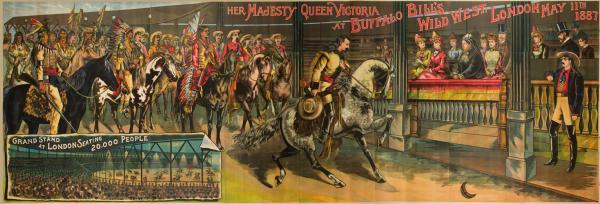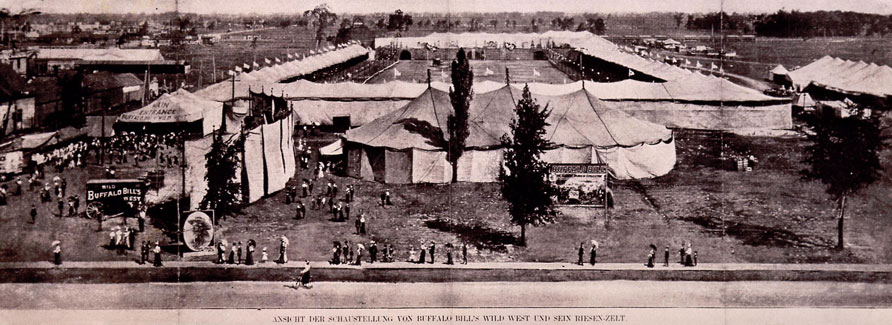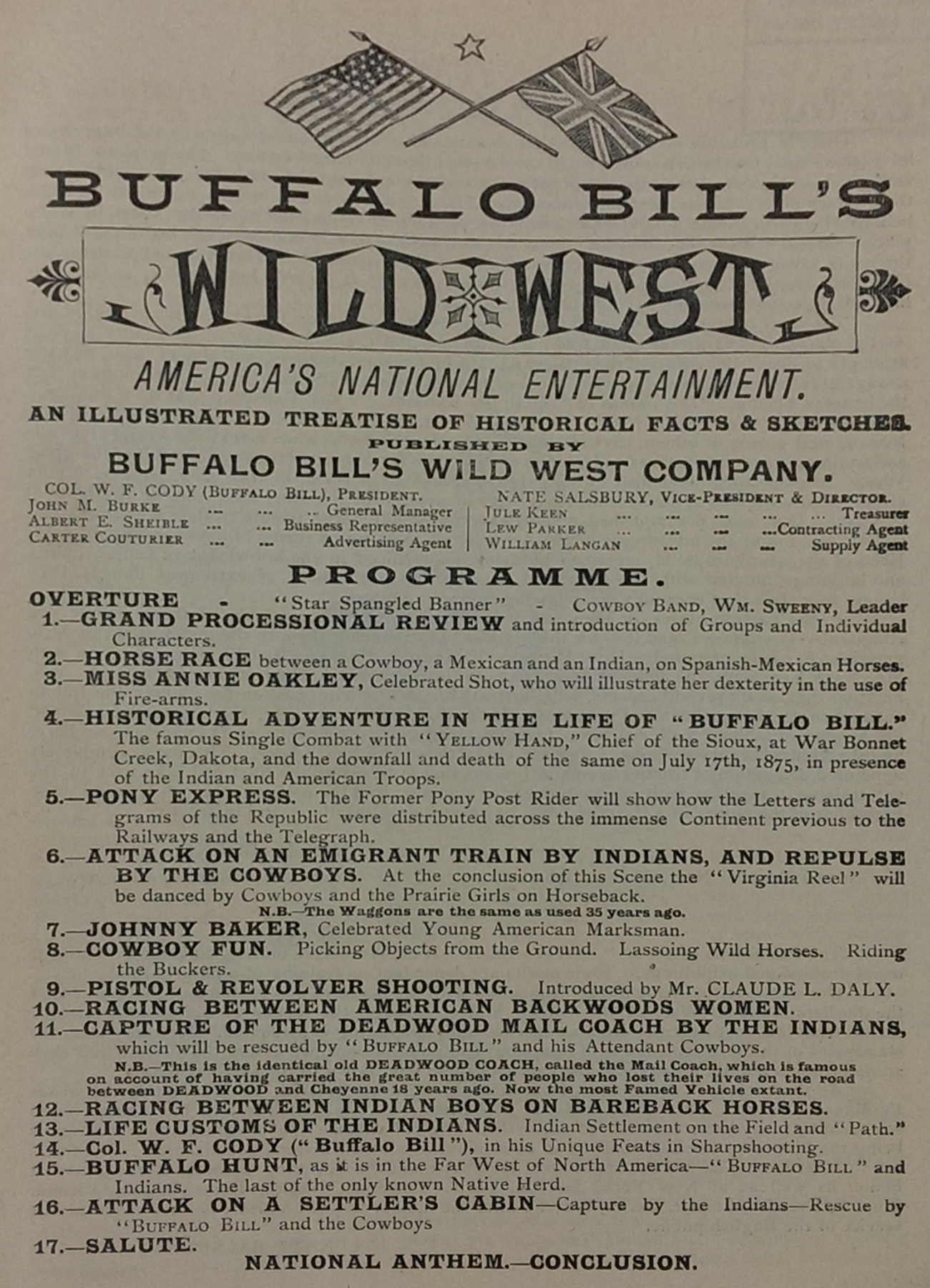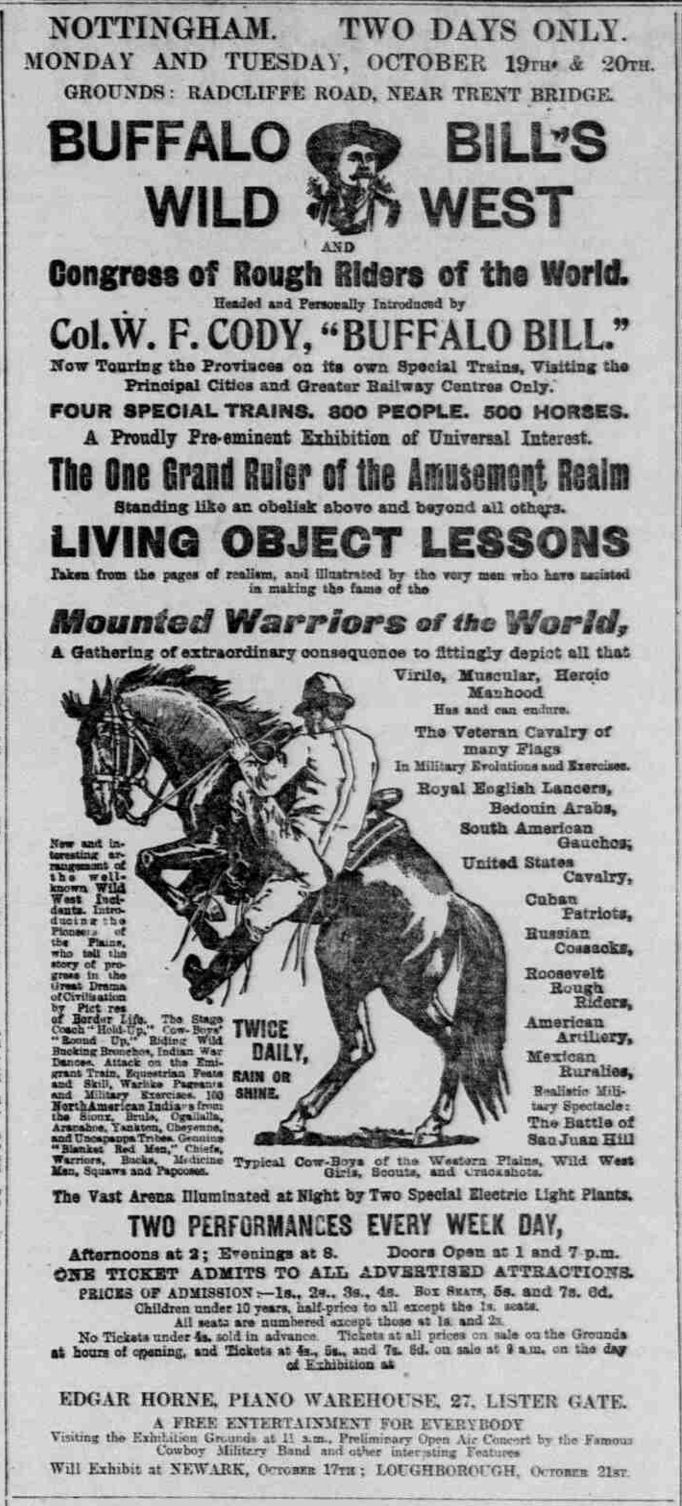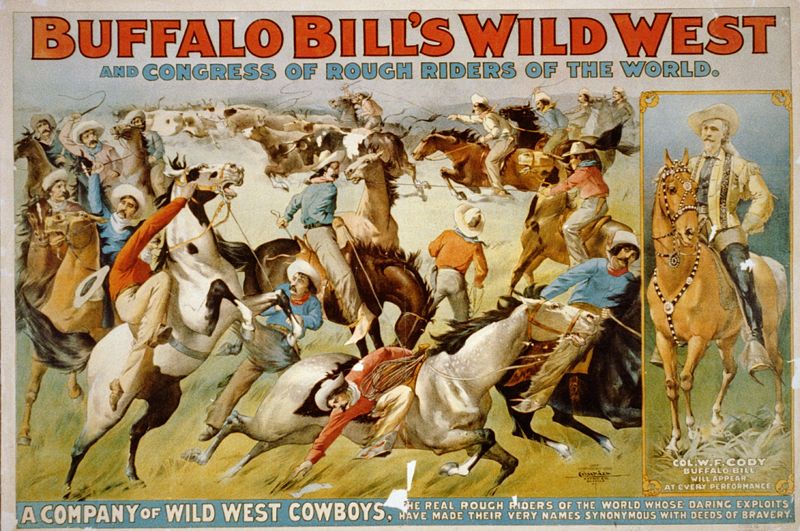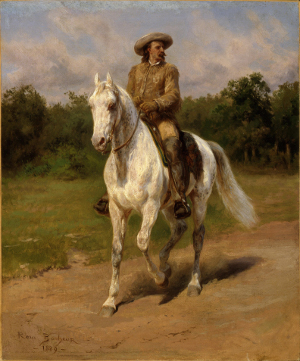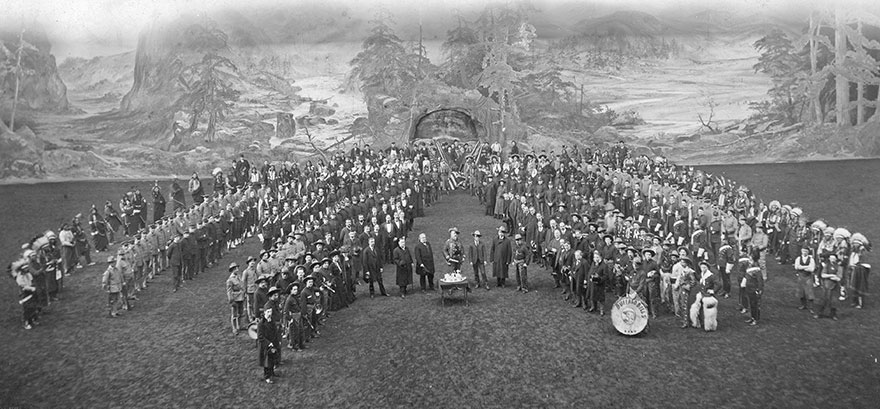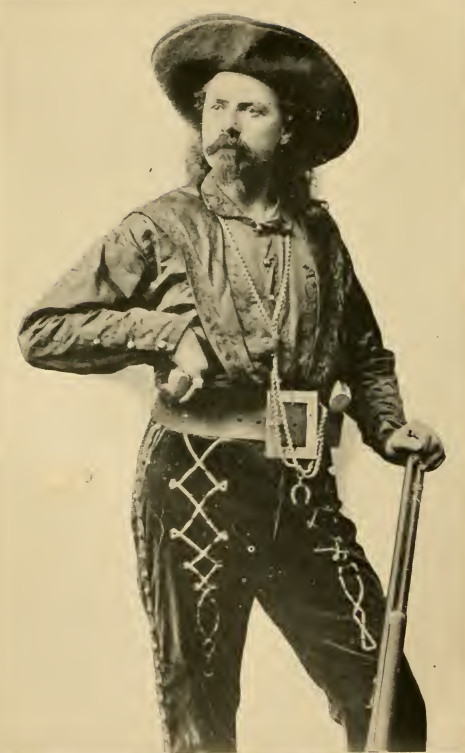 William Frederick Cody (1846-1917) gained renown as a U.S. army scout. He then won his nickname as hunter for the railroad. However, he is best remembered now as “Buffalo Bill” who created his “Wild West Show” and thereby set out the game of cowboys and Indians for generations of children to come. The show was first performed in 1883, and went on to make him his fortune. He described the show in this way:1
William Frederick Cody (1846-1917) gained renown as a U.S. army scout. He then won his nickname as hunter for the railroad. However, he is best remembered now as “Buffalo Bill” who created his “Wild West Show” and thereby set out the game of cowboys and Indians for generations of children to come. The show was first performed in 1883, and went on to make him his fortune. He described the show in this way:1
I conceived the idea of picking out, as it were, the most interesting incidents of my past life, and blending them into a kind of entertainment which should, at the same time, afford the outside world an insight into the real life of a frontiersman, and what he has to contend with. I tried to vivify the life of the prairie, the backwoods, and the trail – the life of the settlement, the dangers of the road, the perils of the emigrant train and the mail coach from Indians and robbers. All these, and many other features of that wild life I worked up into the compact and realistic Exhibition which is now associated with my name.
In 1887, Buffalo Bill and his show set out for Europe with London as its first port of call. There the show became the main attraction at the American Exhibition held at Earls Court. The initial performance was given before the Prince and Princess of Wales and, as Buffalo Bill recounted, was a great success:2
That the Prince was really pleased with the exhibition was shown by the fact that he made an immediate report of it to his mother. Shortly thereafter I received a command from Queen Victoria to appear before her.
This troubled me a good deal—not that I was not more than eager to obey this flattering command, but that I was totally at a loss how to take my show to any of the great residences occupied by Her Majesty.
Finally, after many cautious inquiries, I discovered that she would be willing to visit the show if a special box was prepared for her. This we did to the best of our ability. The box was placed upon a dais covered with crimson velvet and handsomely decorated. When the Queen arrived I met her at the door of the box, with my sombrero in my hand and welcomed her to “the Wild West of America.”
The Queen was so impressed that she asked to see the show again:
A second command from the Queen resulted in an exhibition before a number of her royal guests, including the Kings of Saxony, Denmark, and Greece, the Queen of the Belgians, and the Crown Prince of Austria.
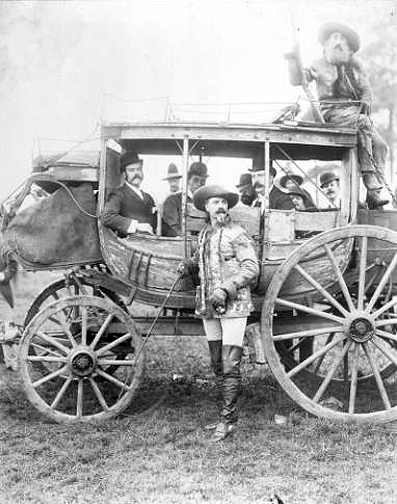 The Deadwood coach, one of the features of the show, was of particular interest to my royal guests. This was a coach with a history. It was built in Concord, New Hampshire, and sent by water to San Francisco to run over a route infested with road-agents. A number of times it was held up and robbed. Finally, both driver and passengers were killed and the coach abandoned on the trail. It remained for a long time a derelict, but was afterward brought into San Francisco by an old stage-driver and placed on the Overland trail.
The Deadwood coach, one of the features of the show, was of particular interest to my royal guests. This was a coach with a history. It was built in Concord, New Hampshire, and sent by water to San Francisco to run over a route infested with road-agents. A number of times it was held up and robbed. Finally, both driver and passengers were killed and the coach abandoned on the trail. It remained for a long time a derelict, but was afterward brought into San Francisco by an old stage-driver and placed on the Overland trail.
As it worked its way East over the Overland route its old luck held steadily. Again were driver and passengers massacred; again it was abandoned. At last, when it was “hoodooed” all over the West and no independent driver or company would have anything to do with it I discovered it, bought it, and used it for my show.
One of the incidents of my program, as all who have seen it will remember, was an Indian attack on this coach. The royal visitors wanted a real taste of Western life—insisted on it, in fact, and the Kings of Denmark, Greece, Saxony, and the Crown Prince of Austria climbed to the box with me.
I had secretly instructed the Indians to throw a little real energy into their pursuit of the coach, and they followed my instructions rather more completely than I expected. The coach was surrounded by a demoniac band of shooting and shouting Indians. Blank cartridges were discharged at perilously close proximity to the rulers of four great nations. Looking around to quiet my followers, I saw that the guests of the occasion were a trifle pale, but they were all of them game, and came out of the affair far less scared than were the absolutely terrified members of the royal suites, who sat in their boxes and wrung their hands in wild alarm.
In recognition of this performance the Prince of Wales sent me a souvenir consisting of a feathered crest, outlined in diamonds, with the words “Ich dien” worked in jewels underneath. A note in the Prince’s own hand expressed the pleasure of his guests in the entertainment I had provided for them.
Amongst the souvenirs produced to mark the visit by Buffalo Bill, was this clay pipe. The design was registered by the pipe maker, Charles Crop of London, in 1887. (Photograph courtesy of Peter Hammond.)
Ever the showman, Buffalo Bill was not slow to capitalise on this royal approval. When he returned home, he commissioned a giant poster – 28 feet by 13 feet (8.5 metres by 4 metres) – to use in his publicity.
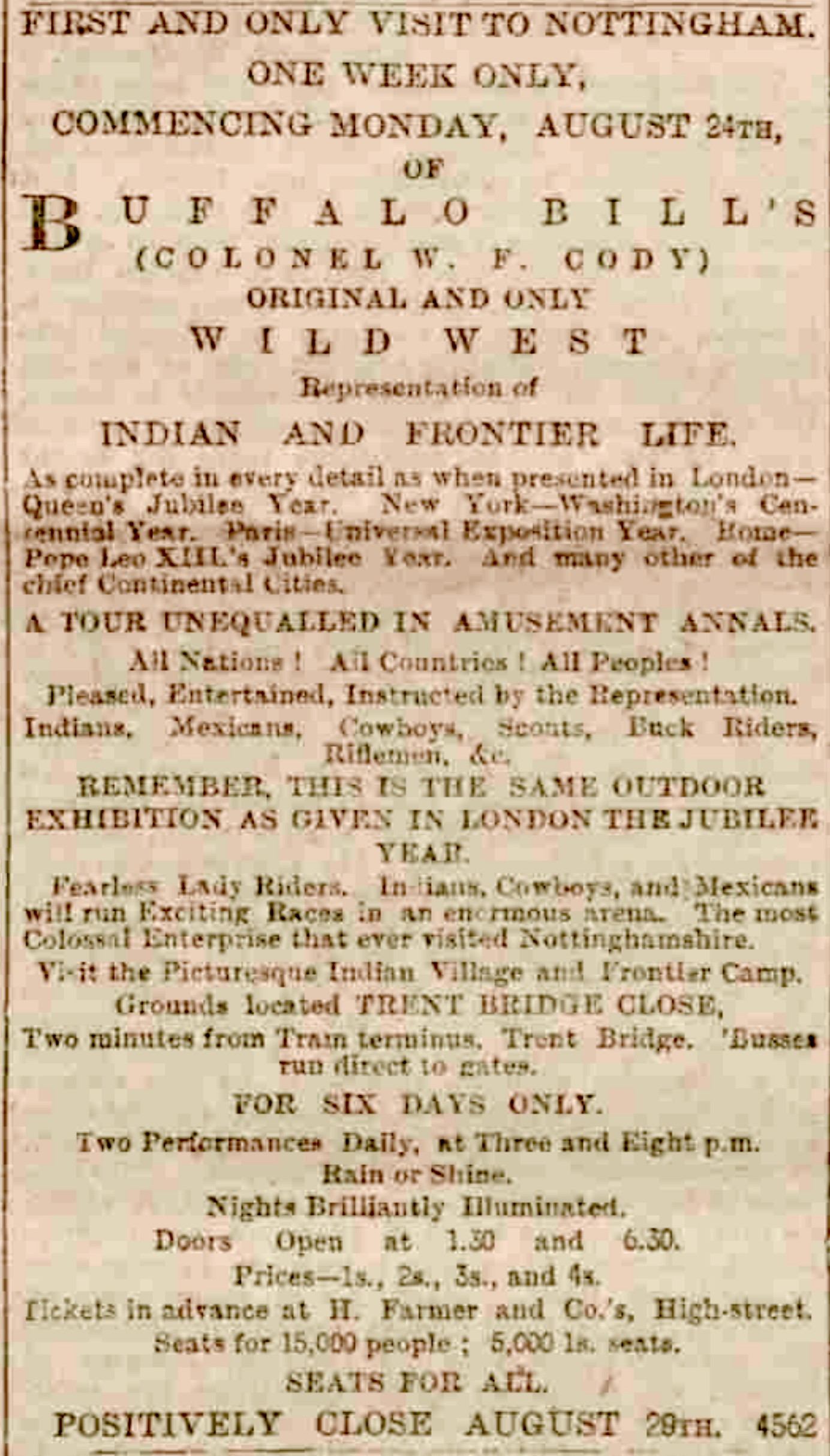 Just a few years later, in 1891, Buffalo Bill brought his Wild West Show to tour England and this time West Bridgford was chosen to host the show for a week. The advertisement3 described it as “the most colossal enterprise that ever visited Nottinghamshire”. With seats for 15,000 people and two performances daily for six days, it would surely be an event never to be forgotten by those who witnessed it.
Just a few years later, in 1891, Buffalo Bill brought his Wild West Show to tour England and this time West Bridgford was chosen to host the show for a week. The advertisement3 described it as “the most colossal enterprise that ever visited Nottinghamshire”. With seats for 15,000 people and two performances daily for six days, it would surely be an event never to be forgotten by those who witnessed it.
The arrival of Buffalo Bill’s camp at West Bridgford on the Sunday must have attracted children from miles around. A local newspaper4 described the scene, which must have closely resembled the one shown in the photograph5 of the show when it visited Germany.
THE “WILD WEST” IN NOTTINGHAM.
Within the last twenty-four hours a little canvas town has sprung up in the suburb of West Bridgford, and it is peopled by a strikingly cosmopolitan crowd of men, women, and children.
The “noble red man” of the Sioux race has pitched his wigwam in the very heart of a civilised community; the cowboy from far off Texas and remote Mexico has his tent and his bucking steed in the same location, and amongst the little army of labourers and assistants in the entertainment which Buffalo Bill, the renowned American scout, has christened “The Wild West,” Frenchmen, Germans, Italians, and Sudanese are to be found. Such a curious mixture of nationalities would be difficult to find outside the nomadic exhibition which Colonel Cody has during the last six or seven years been travelling throughout Europe.
It is no easy matter to transport a number even of disciplined and well-trained troops any considerable distance across country, and it was difficult to realise upon a visit to the “Wild West” camp yesterday afternoon, and seeing the forward state of preparation, that the people and animals there snugly ensconced had been performing at Stoke in Staffordshire on Saturday night. But they had, and during the early hours of Sunday, three special trains, loaded under the direction of Mr Barrie Cowrie, who is Col. Cody’s transport manager, had brought Indians, cowboys, labourers, horses, and buffaloes, together with an enormous weight of material, from Stoke to Nottingham, and the 250 persons had settled down as comfortably as though they had been encamped near Trent Bridge for as many weeks as they had been hours. Fortunately for the travellers recent experience as to weather was not repeated, and they had not to pitch their tents in the pouring rain, a discomfort they have been called upon to endure at Sheffield, Stoke, and elsewhere.
The enclosure, a spacious field bounded on one side by the pleasure walk on the south bank of the Trent, and upon the other by Loughborough-road, is admirably adapted to the purposes of such an exhibition, and is easy of access by ‘bus and tram. Inside a huge arena, which thoroughly admits of the horse being started at a trot, urged into a canter, and ridden out at a galloping speed, has been prepared, and is surrounded by galleries affording accommodation for 15,000 people. The higher priced sections of this great amphitheatre are securely and stoutly canvassed in proof against any sort of weather, and every visitor gets a full view of the performance. The arrangements are, indeed, upon a scale of great completeness, and the organisation of the show, under the direction of Mr Natt Salsbury, Major John M Burke, the general manager, and others of the principal officials is admirable.
Of course, the chief interest centres in the Indians, and it is difficult to realise that scarcely 12 months ago “Buffalo Bill,” Major Burke, and some of the men with them, were engaged at Pine Ridge and Wounded Knee in deadly combat with a large proportion of the Indian “braves” who are now docile members of Col. Cody’s travelling troupe. There is “Short Bull,” the leader of the ghost dances which were preparatory to the coming of an Indian “Messiah,” and led to all the trouble and bloodshed which resulted from General Miles’s expedition to quell the growing Indian insurrection. “No Neck,” “Lone Bull,” “Kicking Bear,” “Bone Necklace,” “Black Heart,” “Revenge” are a few of the expressive names of red men in the “Wild West” encampment – each a picturesque figure with a history. In the course of the entertainments which Col. Cody will give both afternoon and evening during the present week, they will take a prominent part, and assist in presenting vividly scenes of which Fenimore Cooper has drawn such striking word pictures.
The show proper commenced on the Monday:6
THE “WILD WEST” IN NOTTINGHAM.
Colonel Cody and his strong troupe of Indians, Mexicans, cowboys, and scouts gave their first entertainment in Nottingham yesterday afternoon, before probably 7,000 spectators. This, too, in spite of dull weather, with lowering clouds portending rain, and a chilliness in the air quite foreign to August.
Considerable interest and curiosity have been aroused in “Buffalo Bill’s” exhibition of life as it was, and in a degree still is, out in the wild west of America, where the Indian recedes slowly and reluctantly with the big game before the ever-advancing wave of civilisation. The striking personality of Colonel Cody himself, the glamour of an adventurous career, the knowledge that only a few months ago he was a brilliant actor in Indian warfare out west, and the positive assurance of his skill with rifle and revolver, no doubt form the principal attractions of the remarkable show with which he is travelling Europe. But even taking this picturesque personage away, there is no doubt a strong desire amongst people to see for themselves what manner of men these redskins are, to observe their habits, to witness their horsemanship, and to see them engage in mimic warfare. This was shown yesterday by the peering curiosity of the crowds who gathered around the wigwams of the Indians, and investigated in another corner of the big camp at West Bridgford the arrangements which Mexican vacheros, American cowboys and scouts, accustomed to rough life upon the prairies or in the backwoods, make for their comfort under canvas. They were inquisitive as to how the strange visitors from afar generally “live, move, and have their being,” and the camp was fairly well crowded an hour before the entertainment commenced.
Col. Cody began the day’s proceedings by himself heading a procession which traversed the principal streets of the town, and caused quite a congestion of traffic, so great were the crowds to see “Buffalo Bill” and his followers. It was not an imposing cavalcade, but could claim to be perfectly unique, with the historic Deadwood coach, that has traversed hundreds of miles in the Rocky Mountains, now being drawn by sleek, well-groomed mules over the granite boulders of an English midland town. The manner in which people turned out in the streets augured well for the success of the show in the afternoon, and this was the case.
After a few preliminary observations by a very picturesquely attired master of ceremonies, the possessor of a remarkably resonant and clear voice, the grand processional review began. From the distant end of the arena groups of Indians swept at a dashing pace down towards the grand stand uttering war whoops and curious cries. With their finely feathered head gear, brilliantly beaded garments, and vivid war paint, they wheeled at a gallop. The cowboys were less imposing in appearance, but their riding was marvellously good, man and horse behaving almost as one. When all were assembled, and “Buffalo Bill” upon a white steed galloped into the arena there was a hearty cheer. It was an effective sight when, at a word from Colonel Cody, the horsemen and women wheeled left and right and galloped back to their quarters, a brilliant flash of colour which disappeared behind the canvas screen.
Next followed a horse race between an Indian, a cowboy, and a Mexican, which brought about a mishap, the Mexican’s horse slipping up when rounding a treacherous corner, and throwing him heavily. He was badly shaken, but no bones were broken, and with a little assistance he walked from the field amidst sympathetic cheering.
From programme printed by Stafford & Co, Netherfield, Nottm.
Next entered Miss Annie Oakley, “Little Sure Shot,” as she was christened by “Sitting Bull,” the famous warrior, who formerly was with the “Wild West,” but led the hostiles and forfeited his life in the battle of Wounded Knee, near Pine Ridge last spring. She is a wonderful shot, and notwithstanding a brisk breeze which caused the clay pigeons when jerked from the trap to curl away, and a bad light, she made few mistakes. Miss Oakley’s was one of the cleverest features of the afternoon’s entertainment.
Next “Buffalo Bill” rehearsed a scene in his own career, when in the presence of two armies he engaged the Sioux chief “Yellow Hand” in single combat, and slew the Indian. Then we were shown how the riders in the pony express which preceded the era of the railway and telegraph in the far west changed horses with remarkable rapidity, and galloped on in their long and dangerous ride.
One of the prettiest sights was the appearance of an emigrant train, with wagons such as were in use when the earlier settlers were upon their perilous journeys up country, and the realism was heightened when the little party were attacked by Indians, who, however, were repulsed.
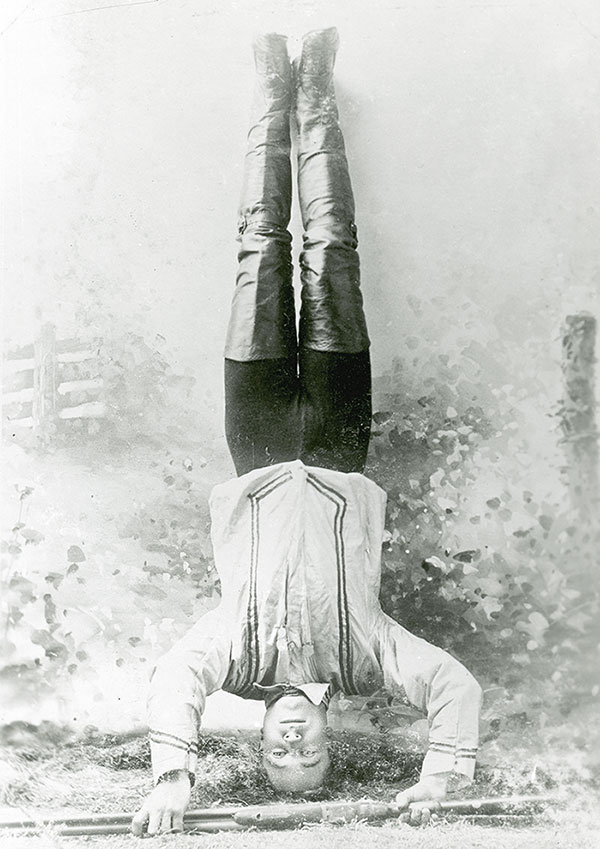 Following this was a pretty bit of riding in the “Virginia reel,” and more clever shooting by Johnny Baker, who, putting himself into various positions, shot from several different weapons with marvellous precision. His great feat is to shoot clay pigeons when standing upon his head, and this he accomplished amidst loud plaudits. There was also a particularly smart bit of revolver practice by Mr Claude L Daly, who seems able to shoot equally well with either hand, and has most prodigiously developed biceps. These feats of arms are indeed very distinctive, and Colonel Cody himself followed them up by breaking a number of glass balls with unerring aim as he galloped round the arena. Of course the attack upon the Deadwood coach was watched with keen interest, “Buffalo Bill” upon this occasion driving, as was his wont in the earlier days of his chequered career. The “cowboy” fun, picking up handkerchiefs from the ground when galloping at a great pace, saddling, mounting, and sticking on the bucking horses, imparted a lighter and less militant touch, and created plenty of laughter. There was more racing between backwoods women and Indian boys, a buffalo hunt, and an attack upon a settler’s cabin; in fact plenty of variety, and altogether an interesting entertainment.
Following this was a pretty bit of riding in the “Virginia reel,” and more clever shooting by Johnny Baker, who, putting himself into various positions, shot from several different weapons with marvellous precision. His great feat is to shoot clay pigeons when standing upon his head, and this he accomplished amidst loud plaudits. There was also a particularly smart bit of revolver practice by Mr Claude L Daly, who seems able to shoot equally well with either hand, and has most prodigiously developed biceps. These feats of arms are indeed very distinctive, and Colonel Cody himself followed them up by breaking a number of glass balls with unerring aim as he galloped round the arena. Of course the attack upon the Deadwood coach was watched with keen interest, “Buffalo Bill” upon this occasion driving, as was his wont in the earlier days of his chequered career. The “cowboy” fun, picking up handkerchiefs from the ground when galloping at a great pace, saddling, mounting, and sticking on the bucking horses, imparted a lighter and less militant touch, and created plenty of laughter. There was more racing between backwoods women and Indian boys, a buffalo hunt, and an attack upon a settler’s cabin; in fact plenty of variety, and altogether an interesting entertainment.
At night the programme was repeated, the arena being illuminated capitally by the Wells light, in which the Indians presented a weird and curious appearance.
One of the regular members of Buffalo Bill’s entourage was not in the show at West Bridgford:7
DEATH OF “EAGLE STAR”
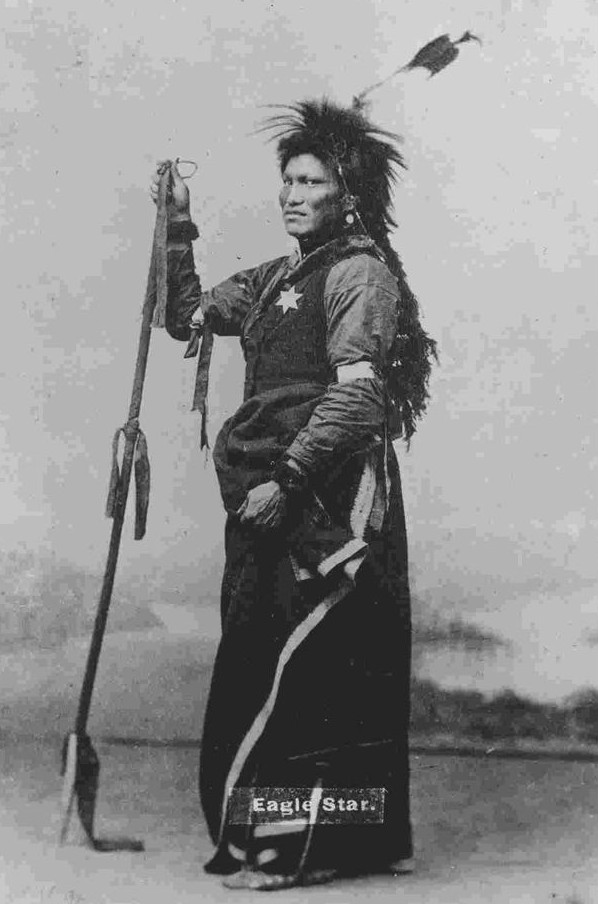 Paul “Eagle Star,” one of Colonel Cody’s Indians died yesterday at the Sheffield Infirmary, from an accident which befell him whilst the “Wild West” show was on a visit to that town. He and a number of other Indians were riding in the arena, when his horse swerved against a part of the hoarding. “Eagle Star” sustained a compound fracture of his leg, one of the fractures being close to the ankle. For a time he made favourable progress, but lock-jaw set in, and from this he died. Mr Crager, Colonel Cody’s chief interpreter, sat up with him the whole of Sunday night, and he was visited also by “Short Bull,” one of the Indian chiefs. The deceased was a Bruce Sioux Indian, 35 years of age, and was a prisoner of war, having taken part in the last Indian rising. He was married. His wife and children are living in the Rosebud Agency, United States. There were some strange sounds from the Indian camp at Nottingham in the evening for the squaws and the braves having become apprised of the loss spent part of the evening in perambulating the tents, chanting a dreary dirge of lamentation for their dead comrade, who will be buried at Sheffield.
Paul “Eagle Star,” one of Colonel Cody’s Indians died yesterday at the Sheffield Infirmary, from an accident which befell him whilst the “Wild West” show was on a visit to that town. He and a number of other Indians were riding in the arena, when his horse swerved against a part of the hoarding. “Eagle Star” sustained a compound fracture of his leg, one of the fractures being close to the ankle. For a time he made favourable progress, but lock-jaw set in, and from this he died. Mr Crager, Colonel Cody’s chief interpreter, sat up with him the whole of Sunday night, and he was visited also by “Short Bull,” one of the Indian chiefs. The deceased was a Bruce Sioux Indian, 35 years of age, and was a prisoner of war, having taken part in the last Indian rising. He was married. His wife and children are living in the Rosebud Agency, United States. There were some strange sounds from the Indian camp at Nottingham in the evening for the squaws and the braves having become apprised of the loss spent part of the evening in perambulating the tents, chanting a dreary dirge of lamentation for their dead comrade, who will be buried at Sheffield.
In fact, the funeral of “Eagle Star” took place at West Brompton on the Tuesday. The coffin was taken on board a train at Sheffield, which then stopped to collect several of the Indians, who had been elected to attend the funeral. That night there was a violent storm, which tore some of the canvas at the show into shreds. Over a hundred years later, in 1999, “Eagle Star’s” remains were exhumed and taken to be reburied in Rosebud.
The Indians returned from the funeral in time for the Wednesday afternoon show. By that time the weather had turned fine and there were 12,000 spectators; unfortunately the improvement in the weather was not sustained and there were frequent showers of rain. However, there was a novel addition to the show:8
An extra event was introduced into the programme, when the cowboys gave an exhibition of their skill in saddling, mounting, and sticking upon the backs of the bucking horses which form part of “Buffalo Bill’s” stud. Some doubt has been expressed as to the genuineness of the antics of the confirmed bucker when attempting to get rid of anything put upon his back, and a gentleman from Langar, near Elton, sent a perfectly unbroken and untrained horse to the “Wild West” yesterday for the Mexicans to practise their arts and their riding upon. Th animal was full of mischief, and for a time defied all efforts to saddle him, but the lasso and skill of the American roughriders combined prevailed, and when once one of the the Mexicans got into the saddle the horse found it impossible to shake him off. This English blood horse had, when bucking, precisely the same actions as those of Mexican extraction brought by “Buffalo Bill” from across the seas, and the plucky rider who commenced the education of the animal from Langar in the arena at West Bridgford, was loudly cheered for his skilful management of the horse.
The evening performance was largely attended, but heavy rain falling just as the proceedings were about to commence, had an adverse effect.
On the Wednesday evening, some of the cowboys from the show were invited to the Southern Division Conservative Club on Angel Row in Nottingham for a game of skittles, which the cowboys won.9 The other entertainment for the evening included “a capital programme of music” and “a clever imitation of birds and bird whistling”. Mr Snyder, of the cowboys, thanked the members and proposed a toast to “The Health of the Queen”
The Saturday afternoon performance was very nearly marked by a tragedy, as reported in the Nottingham Evening Post:
ALARMING ACCIDENT AT THE WILD WEST SHOW.
NARROW ESCAPES.
EXCITING SCENES.
An accident which caused the gravest excitement, but was fortunately unattended by any very serious injury, occurred this afternoon on the ground near Trent Bridge occupied by Buffalo Bill’s Wild West Show. Some thousands of people had assembled to witness the performance, the arena being lined by people standing several deep, whilst the stands were crowded. The show began at three o’clock, and after the customary parade indicative of the general character of the exhibition, Miss Annie Oakley entered the ring to commence her shooting feats. At this moment the attention of the large body of spectators were diverted to the Loughborough-road side of the ground, whence loud cries were proceeding. The occupants of one of the shilling stands were seen to be in a state of considerable panic, and the explanation of this untoward occurrence was immediately afterwards supplied by the cracking of timber and the collapse of the entire structure. Except some few on the lower seats who were able to jump off, the whole of the occupants of the stand were thrown in a mass to the ground.
Great consternation prevailed, and spectators from various parts of the field rushed to the spot, the wildest speculation prevailing as to the extent of the personal injuries. At first it was feared by some that if at least one or two persons had not been killed many had been seriously injured, but speculation on this point fortunately proved to be very wide of the mark. There were most of the elements of a serious catastrophe, but by marvellous good fortune all but one or two of the spectators escaped. The only serious injury was in the case of Owen Richardson, a man of about 40, living at 75, Lamcote-street, who it was found had broken his ankle. There were one or two others who complained of slight contusions, but as far as could be ascertained Richardson’s was the only case of any absolute fracture of bones
Immediately upon the fall of the stand Col. Cody’s men and the officers of the borough police on duty rushed in haste to the help of those who had been thrown to the ground, and there was no lack of other willing helpers. The broken planks and other débris were quickly removed, and no appreciable time had elapsed before a clear space was made upon the spot and the true extent of the injuries become known. Richardson, whose ankle was broken, was removed in a cab to the General Hospital, where his injuries were attended to by the house surgeon, Mr. J. P. Gray. One lady, whose name did not transpire, but who was stated to have sustained a slight wound, was conveyed to her home in a cab, whilst many people complained of the severe shaking which they had experienced. To all who exhibited the slightest sign of injury Colonel Cody’s staff were assiduous in their attentions, and after the accident the former occupants of the stand were accommodated with seats in the other enclosures, Col. Cody being able to make from the ring a reassuring statement as to the nature of the accident which had given rise to such great alarm
The stand which collapsed was about 30 yards long, and contained eleven rows of seats, accommodating about 800 people. It was composed of timber baulks supported by cross pieces and “v shaped ” jacks, with little iron work attached. The suggestion is that the accident was due to several people climbing up and shifting the position of one of the “ jacks,” so that owing to the softness of the ground the supports tilted one after the other under the weight of the people on the seats above. The stand come down with a rush, and some of the people on the higher seats were precipitated at distance of several feet. Had there been anybody under the structure at the time the result could not here been otherwise than fatal. As it was it was a matter of general relief that the accident was attended by such comparative slight consequences, and in the gratification expressed upon this head nobody seemed more cordial then “Buflalo Bill” himself, under whose personal direction the show was continued after the accident, as though nothing had happened to mar the afternoon’s proceedings.
That evening’s performance was the last at West Bridgford:10
THE WILD WEST SHOW.
On Saturday night, when the final performance was given, nearly 8,000 people paid for admission. The Indian encampment was broken up early in the evening, and upon the close of the show a large staff was engaged in removing the various other properties, which were conveyed in special trains to Leicester where the “Wild West” will be located during the present week.
The popularity of the shows had unfortunate repercussions for some conductors on the local transport:
OVERCROWDING AN OMNIBUS.11
Wm. Cawthorne, of 47, Garfield-road, was summoned for allowing an omnibus, of which he was the conductor, to be overcrowded on the 25th of last month. P.s. Bowley, who proved the case, said that defendant had charge of an omnibus running between St Peter’s-square and “Buffalo Bill’s” show. The ‘bus had 35 persons on the vehicle. Defendant was fined 10s.
OVERCROWDING A TRAM-CAR.12
Jonah Fossey, of 2, Curtis-street, tram conductor, was summoned for allowing a tram-car of which he was the conductor, to be over-crowded, on the 29th ult. P.c. Woodward, who proved the case, said the defendant had 58 passengers on his car, whereas it was only constructed to carry 44. Defendant said that on the day in question there were a great many people at the tram terminus on account of the Wild West Show at Bridgford, and he was unable to keep the people off the tram. Defendant was fined 10s.
Buffalo Bill brought his show to West Bridgford just once more, in 1903. This time he set up camp on Radford Road:13
By now, the show was even larger, with 800 people, and travelled on board four special trains. Horsemanship was the theme of the show, which featured the “Congress of Rough Riders of the World”:14
BUFFALO BILL IN NOTTINGHAM.
OPENING OF THE WILD WEST SHOW.
All the deeds of daring and romantic adventure ever dreamed of by Fennimore Cooper find a parallel in the career of Buffalo Bill, who, heading his “Wild West” show, commenced a two-days’ engagement in Nottingham to-day. Noted as a cunning plainsman, a mighty hunter, and a fearless scout, the name of Colonel W F Cody has for many years been familiar to the folk of both hemispheres, and thigh position which he has occupied has been worthily upheld.
It is as a great showman, however, that the public on this side of the Atlantic know and admire Colonel Cody, whose periodic visits to Europe have always been received with the utmost appreciation. Twelve years have elapsed since the gallant colonel last performed in Nottingham, and his appearance upon the present occasion has excited considerable interest.
Enormous crowds have assembled in the vicinity of the selected position on Radcliffe-road, West Bridgford, from the time that the huge aggregation reached its site, and despite the fact that the weather was far from propitious there was a numerous attendance at the opening performance this afternoon.
Recent events in connection with both England and America have demonstrated beyond question the effectiveness of the rough rider in modern warfare, and it is just this fact which Colonel Cody has chosen to demonstrate, with results of the most gratifying character. “Rough” riders the Cody forces certainly are, in the sense that all mounts come alike to them, and the illustrations given by the different sections of horsemen of their special methods of employing their steeds are of the most curious and attractive nature. Practically the horse enters into every item on the long programme, but so diversified is the entertainment that there is no lack of variety, and the “turns” follow one upon another with the celerity imparted by the complete organisation, which is to be found in the most perfect form in connection with the Wild West Show, both in the arena and behind the scenes.
Under cover and safe from the worst conditions as regards the weather, 14,000 people are able to watch the show in comfort, while so far as the performers are concerned, if it rains cats and dog, the programme is gone through in its entirety. Colonel Cody and his companions, hardy plainsmen, inured to every vagary of the weather, take no account of such occurrences, which have, it is a regrettable fact, been common enough during their tour in Great Britain, now drawing to a close.
The show opens with an imposing display by the whole mounted company. At the far end of the arena, the cleverly painted cloths are pulled apart at the blast of a bugle, and then gallop up the arena row upon row of Indian chiefs and braves, uttering shrill, birdlike cries, and wheeling in admirable order. Closely following one upon another come representatives of the various other nationalities, composing Cody’s “Congress of Rough Riders of the World,” cowboys from the Texan plains, Cossacks from the Caucasus, “ruralies” from Old Mexico, Arabs, Riffs, and Bedouins from the desert, gauchos from the Pampas, American cavalrymen fresh from Cuban service, and English cavalrymen who have served in South Africa, dragoons, lancers, mounted infantrymen, &c. Advancing to the top of the arena they form rank one behind another, until the most curiously bizarre regiment the fancy could conceive is before the eyes of the spectators.
Then a solitary horseman is seen swinging along the ride at a hard gallop. It is Buffalo Bill himself, and his recognition is cordial to the borders of enthusiasm. Rushing to the head of his men, the colonel turns in his saddle, salutes with a sweep of the great sombrero, and at once sets his forces in motion. Wheeling to the right and left, the horsemen give a brief musical ride prior to retiring. Colonel Cody’s seat in the saddle is as firm as it has been at any period of the time during which he has “witched the world with noble horsemanship,” and ranked as one of the most perfect examples of the mounted man ever seen. It will be remembered that he and his famous white charger afforded Rosa Bonheur with one of her best subjects. The great animal painter spent weeks in Buffalo Bill’s camp in Paris. That, however, is by the way. Coming back to the programme the next feature is an exhibition of feats in the saddle by a cowboy, a Cossack, a Mexican, Arab, Gaucho, and Indian, and a curious spectacle is afforded, as the riders gallop madly around the arena. Veterans of Battery D, Fifth Regiment, United States Artillery, give a smart display of rapid drill, unlimbering and limbering up with surprising quickness and demonstrating muzzle-loading methods of days gone by.
An old-time incident is illustrated in the representation of a prairie emigrant train crossing the plains, the camp fire, the quadrille on horseback, and the attack by Indian marauders, whom the scouts and cowboys eventually repulse. It is a stirring little incident, and capitally arranged. And then comes what to many among the spectators is undoubtedly the chief attraction of the show, the display of marksmanship by Colonel Cody, who, riding a galloping horse, breaks balls thrown high into the air by an assistant riding well in advance, with almost unerring aim. It is a marvellous exhibition, for the objects are but small, and the colonel’s fine Kentucky mount is going at full speed all the while, but those which he fails to break are but few,
Marksmanship of an even stranger nature is shown by Johnny Baker, the renowned young Yankee, who hits similar objects from all manner of unconventional positions, and proves himself possessed of unique powers as a shot.
With the major portion of the spectators one of the most popular portions of the programme is that in which the bucking horses are introduced and ridden by the cowboys. These Western Range horses are kept specially for the purpose, and so far from having been trained to this business they are kept specially unbroken and only used perhaps once a week, in order that the natural conditions of saddling, mounting, and riding may be actually reproduced. Controlled by the lariats of the Mexican contingent, the animals are soon thrown, saddled, and mounted, and then the fun begins. Kicking, plunging, and bucking, the horses dash madly towards the stables, and how some of the men keep their seats is a matter for astonishment, but falls are rare, and the exhibition is one of the greatest possible interest.
So, too, is that in which the Mexicans illustrate the throwing of the lariat, an accomplishment in which they possess wonderful skill, successfully lassoing everything within range, large or small, animate or inanimate. A curious group are the Cossacks, who give a display of horsemanship showing the ease with which they are able to advance close to an enemy without being seen, a feat in which their adroitness rivals that of the Indians themselves. During Napoleon’s retreat from Moscow they were terribly effective, and were styled by the French the “Snow Wolves” as, like the American Indian, who paints himself green, or yellow, or brown, and rides a in leaguing with the foliage of the season, the Cossack dressed in white, rode white horses with white accoutrements and dashed across the snow-covered ground, hidden behind their horses, almost invisible until they plunged amid the panic-stricken enemy like ghostly apparitions. Sergeant Bourgeron’s description of the horror of Napoleon’s retreat intensifies its terrors, stating that herds of riderless wild horses were suddenly transformed as if by magic into a storm of slashing, shooting, devastating adjuncts in the shape of Cossacks in the saddle.
Almost equally remarkable is the bareback riding of the American cavalrymen, who ride and control two and three horses at a time while standing on the backs of the animals. And this, it should be borne in mind, is not in a regulation circus ring, when the balance can be calculated, but on a straightaway gallop. These are the chief incidents of a programme which is replete with interest and excitement from start to finish.
The performance will be continued this evening, when the arena and the whole of the showground will be illuminated by immense arc lamps.
West Bridgford was one of the last stops on his tour, so Buffalo Bill advertised:15
In view of the approaching close of his season, Colonel Cody desires to announce that he has a few Riding Horses for Sale, which may be seen on application to Jon Esqueval, at the Exhibition Grounds, Radcliffe-road, Trent Bridge.
This old film footage gives a taste of what the visitors to Buffalo Bill’s show would have been able to see:
References:
1 Derby Daily Telegraph 22nd August 1891
2 William Frederick Cody An Autobiography of Buffalo Bill 1920
3 Nottingham Evening Post 8th August 1891
4 Nottingham Evening Post 24th August 1891
5 Buffalo Bill Center of the West P.69.1512 – Gift of Thomas Isbell
6 Nottingham Evening Post 25th August 1891
7 Nottingham Evening Post 25th August 1891
8 Nottingham Evening Post 27th August 1891
9 Nottingham Evening Post 27th August 1891
10 Nottingham Evening Post 31st August 1891
11 Nottingham Evening Post 4th September 1891
12 Nottingham Evening Post 10th September 1891
13 Nottingham Evening Post 17th October 1903
14 Nottingham Evening Post 19th October 1903
15 Nottingham Evening Post 19th October 1903


